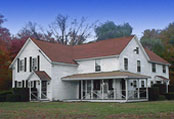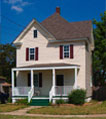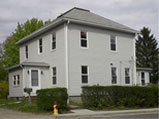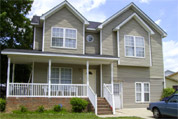|
Profile of Oxford House™ Residents in Fifteen Jurisdictions Download PDF of this document The following represents data from 2,290 interviews of Oxford House™™ residents out of a possible 2,828 (81 % response rate). All but data from Missouri, Nebraska and Washington State was collected in June 2004. Missouri data was collected in the first quarter of 1994 and represents a historic [approximately 10 year] benchmark. The Washington State data was collected June 2002. The Nebraska data was collected in November 2002.  As of June 2004, the average weekly share of house rent and household expenses was $87.50 per week ($379 per month) -well within the average monthly income of Oxford House™™ residents. The monthly income figures shown below are in current dollars except Missouri [1993] and Washington State [2002]. The national average weekly equal share of expenses was $67.50 in 1993 and $79.50 in 2002.  Reflecting the color-blind nature of alcoholism and drug addiction, Oxford Houses have a racial mix of residents. In each state the racial mix over-represents minority populations. Asians, Pacific Islanders, Hawaiians and Native Americans are included under "other" in the table below.  Oxford House™ residents cover a wide age range from 17 to mid-seventies. The self-support requirement tends to make it difficult for individuals under age 17 to live in an Oxford House™™, but residents from 17 to 35 often work.and go to school to catch up on education missed or to learn new job skills.  On average 21.5% of Oxford House™residents are veterans. State by state the range is from 12 percent in Hawaii to 29 percent in Missouri. The percentage of veterans is higher whenever outreach workers work with Veteran's hospitals.  The average age of Oxford House™ residents surveyed is 38.5. This is about 4 years older than the average age was in 1994. There may be three explanations for this "aging" of the average age. First, the rate of new Oxford House™s openings is less today than it was ten years ago while individuals in established houses are aging along with the house bUI not reaching out to establish new houses for younger individuals entering recovery. Second. Pennsylvania, Texas, South Carolina, Connecticut, Virginia, Maryland, District of Columbia -making up half of the June 2004 survey -rely almost exclusively upon Chapter expansion rather than paid outreach workers or central service office direction to create clusters of new housing. Third. those in established houses are slower to open new houses and tend to be highly selective in accepling new residents by favoring individuals "just like us" in both age and experience  About a quarter of Oxford House™™ residents are going through the recovery process for the first time (21.6%). At the other end of the spectrum about 18% have gone through treatment (fonnal residential treatment in addition to detoxification) more than ten times before becoming Oxford House™nl residents. Over one-half have been through residential treatment (in addition to detoxification) three (3) or more times prior to residency in Oxford House™.  Whether a resident had been through residential freatment once or many times individuals are able to stay clean and sober without relapse. The table below shows the months of current sobriety for each of the various times through prior treatment. Notice that "one" or first time through treattnent permitted residents to gain as much or more sobriety than any other category. Think of the treatment cost savings if everyone had an opportunity to live in an Oxford House™ T)f after treatment.  The most striking comparison between the present Hving environment of the Oxford House™Ul resident and the past living environment is seen when the matter of homelessness is examined. About one-half of all Oxford House™TN residents have experienced homelessness during their addiction 10 alcohol and lor drugs. The average length of homelessness among these Oxford House™TN residents is about 6 months. The number of times an individual had been homeless varies among residents within a state and even among residents between states. For example. the average number of times New Jersey residents had been homeless was 1.7 while Washington State residents had been homeless an average of 3.4 limes. Table 8 shows the percent of Oxford House™ Tl( residents by state who had been homeless during their addiction.  An "informal" treatment for alcoholics and drug addicts is >oflen serving jail time. Within the past five years. more correctional facilities have formalized treatment for inmates who are alcoholics or drug addicts. However. for most alcoholics and addicts in jail the "lTeatment" is informal. Most will detoxify. Some will receive the education, motivation and techniques of behavior change to avoid future use of alcohol and drugs. Among Oxford Hous residents' substantial percentages have served jail time. The average length of jail time is I year, I month. Table 10 shows the percentage of Oxford Hous residents who have served jail time by state.  The marital status of Oxford House™™ residents is shown in Table 11. In all the survey questionnaires the category "single" was defined as "Never married." Overall, the marital status of Oxford House™ residents suggests that few marriages withstood the effects of alcoholism and drug addiction.  Where an individual was living just prior to the treatme·nt that preceded his or her moving into an Oxford House™Till shows the marginal living conditions of a large percentage of residents. For example, an average of 40% came from either rented rooms, institutions or were homeless. But for Oxford House™nc, many could have been expected to return to these marginal living situations.  Looking at specific behavior of Oxford House™™ residents can be useful in evaluating whether or not an individual's activity is reflective of a serious effort to develop new behavior. One activity that directly measures seriousness in developing behavior to assure sobriety is attendance at Alcoholics Anonymous and Narcotics Anonymous meetings. There is no requirement within an Oxford House™™ that residents attend such meeting but both peers and the Oxford House™"culture" encourage meeting attendance. In every state survey 12-step meeting attendance was high.  A derivative of AAI NA meeting attendance data from the sUlVeys is the percentage of Oxford House™™ residents recovering from addiction to cocaine, heroin, crack or other illegal drugs in addition to alcohol.  Another indication of the seriousness of an individual to develop new behavior is attendance at counseling sessions in addition to AA and NA. The surveys of Oxford House™residents in the various states show that an average of 44% went to weekly counseling sessions.  The two final statistics are bottom-line staying clean and sober. The relapse rates among the states varied between 19.1 % and 30%. The national average relapse rate for all Oxford Houses is 19.8  For more information about Oxford House™, contact the central services office.
|
||||||
| ||||||
.gif)




